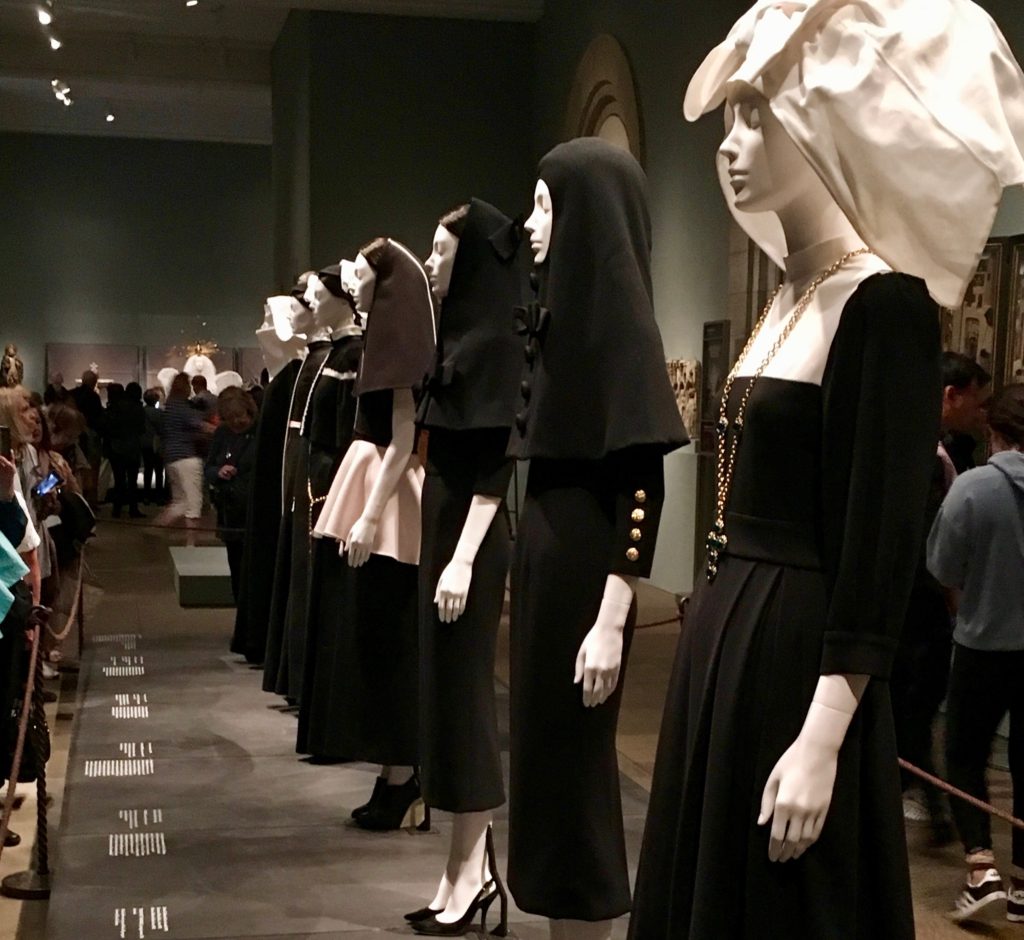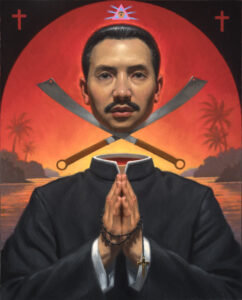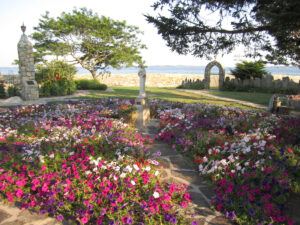The best plaque at the Metropolitan Museum of Art’s exhibit Heavenly Bodies: Fashion and the Catholic Imagination has little to do with the fashionable ensemble it accompanies. It instead takes the fact that designer Rossella Jardini is riffing on the starched cornette of the Daughters of Charity (think The Flying Nun and you’re on the right track) to launch into an anecdote about Charles de Gaulle. Apparently, the statesmen felt such affection for the Grey Sisters’ traditional habit that, when he heard the order was changing its headgear from that wing-like wimple to a soft veil, he declared, “One might as well suggest changing the French flag!”
De Gaulle’s consternation is droll. But for those with some knowledge of history, there’s irony to juxtaposing the French flag and the religious attire of the Daughters of Charity. The Revolution that raised that Tricolour also threw those sisters from their motherhouse and forced them to swear an oath to the Revolution. Those who refused were publicly executed. As four of these sisters awaited the guillotine, their guards confiscated the sisters’ prayer chaplets. Unsure of what else to do with them, the guards dropped the chaplets onto the sisters’ heads, anticipating the crowns of martyrdom they would shortly wear.
The fact De Gaulle could, less than 200 years later, see the sister’s headwear as quintessentially French is a testament to… something. Certainly to the devotion of the Daughters of Charity in their charism of service to the poor through works of mercy. But also to the way the radical strangeness of the Church can permeate and leaven a culture that never quite understands it.
Which brings us back to Heavenly Bodies.

The exhibit snakes its way through the Met’s existing Byzantine and medieval art collection, including the entirety of the Met Cloisters, the branch devoted to medieval Europe. The fashion design on display, therefore, is placed in counterpoint and conversation with medieval tapestries, carvings, and (at the Cloisters) entire rooms plucked from churches and abbeys.
The exhibition notes give a sense of what the curators hope the exhibit will reveal: “Heavenly Bodies features the work of designers who for the most part were raised Catholic. While their current relationships to Catholicism vary, most acknowledge its enduring influence on their imagination.”
This rather suggests the fashion on display in the upstairs galleries springs largely from the lapsed Catholic imagination. So the treasury of Papal vestments lent by the Vatican on a floor below in the Met’s Anna Wintour Costume Center creates an interesting contrast.
Here we see, for example, a set of dalmatics for Pope Pius IX produced by the Istituto Femminile di Don Nicola Mazza. (A dalmatic is a wide-sleeved long tunic worn by deacons and other clergy; it also garbs the monarch of England during the coronation ceremony.). These vestments depict paired Biblical scenes on either side: The murder of Abel/the binding of Isaac, the scourging at the pillar/Christ carrying the Cross, etc. These garments were made for churchmen by devout women, whereas the main ensembles of the exhibit were (mostly) designed for female models by not-currently-practicing men. Each set of creators deck bodies unlike themselves in symbols of the holy. The degree of reverence afforded the bodies and the symbols vary.
Sometimes the level on which these fashionistas works engage with Christian imagery is shallow. Versace offers gold lamé evening dresses with cross appliques slapped on them haphazardly. But some fashion here is striking and beautiful in ways that are enhanced by looking at it with Catholic eyes. At the Cloisters, several Marian dresses have theology woven into them.
Valentino turns the mantle of the Black Madonna of Częstochowa into a black, star-studded caped dress that shows Our Lady both as in mourning and as queen of heaven, a reminder that the sorrowful mysteries of our faith and the glorious ones coinhere. Jean Paul Gaultier printed a stained-glass Virgin and Child onto a silk chiffon evening dress so that a model wearing it would appear to be cradling the infant Jesus. The designer intuits Mary’s glory is like that of glass: Her purity and clarity allow God to shine through her into the world. It’s a lovely reminder that chastity is not a “no,” but an emphatic and powerful “yes” to God.


But the exhibit, like the Met Gala that greeted its opening, is limited in some important ways. As Catherine Addington observed, the Catholic Church is, true to its name, a global body, but this collection treats Southern Europe as the focal point of the “Catholic Imagination.” The faithful in Latin America, the underground church in China, the vocations boom in Africa—as an American Catholic, I’m inspired by the vibrant witness of the worldwide Church. It would have been interesting to see what couture designers could have come up with from a similar inspiration.
Moreover, many designers spend a lot of time chasing the austere grace of religious habits. Sometimes this results in striking, monochromatic designs, like a Valentino evening dress evoking the Dominican tunic and cappa magna. Sometimes the upshot is sophomoric, like Rick Owens’ monkish ensemble with a crotch hole or Carli Pearson’s “fetish nun.”
Catholic folk art certainly has its share of kitsch, so it’s no surprise to see these designers indulge in the trite blasphemy of ex-Catholic kitsch. Still, it’s a bit rich for the curators to label something like the fetish nun provocative or progressive as if treating all women as objects of titillation or tantalization were not merely a depressing default. The true radical stance is the Church’s, in calling women and men to dedicate themselves, body and soul, to a good above the order of nature.
In contrast to the fetish nun, Gareth Pugh’s futuristic ensembles with cross-patterned zippers are intriguing innovations rather than rote ribaldries. I would read science fiction about the space inquisitors who wear such outfits.


For every steely, seraph-inspired dress by Alexander McQueen or exuberantly-haloed Rodarte ensemble inspired by Bernini’s Ecstasy of St. Teresa, there’s a billowy, pillowy angel that would never have to say, “Be not afraid.”
The Bride of Christ is beautiful and strange and holy, fair as the moon, clear as the sun, terrible as an army with banners. Sometimes, the fashion at The Met touches on that holy fear. Other times it falls short: Ross Douthat remarks that the couture bondage mask on display is completely shown up by the 16th-century memento mori-themed rosary next to it; the rosary features ivory beads carved into half-flesh half-skeletal faces.
In the world of fashion, the body is all there is. Therefore the body must be starved and flaunted. For Catholics, the body points to a reality beyond itself, both in its beauty and its dissolution. And so the body must be cared for as a temple of the Holy Spirit.
It’s fortunate the Met has woven this fashion show into its treasure trove of religious art. We see both how secular high fashion can genuinely be influenced by a truly Catholic imagination and how it can never encompass it.
Alexi Sargeant is a writer living in New York and the New York Editor of Catholic Arts Today.




